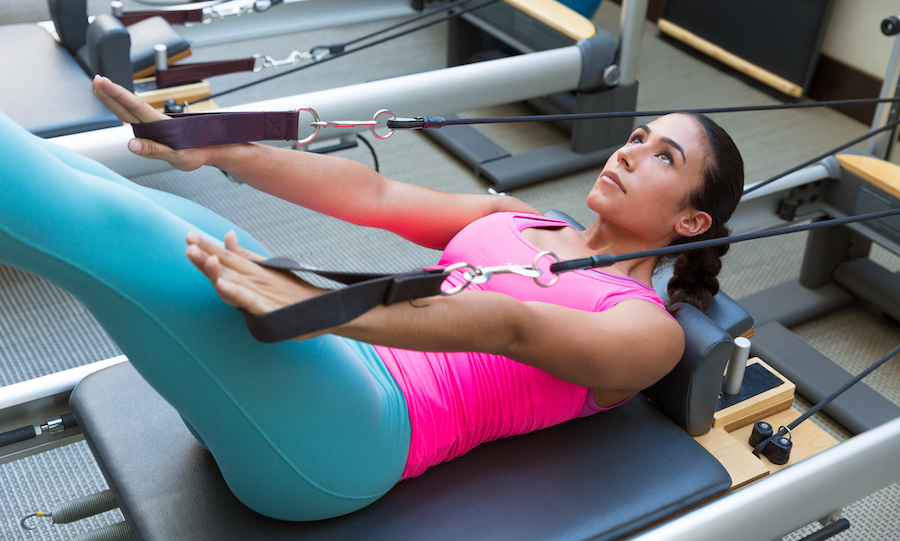Pilates is taking the world by storm as more and more individuals are learning about the multitude of benefits it can bring. Read on to find out out what Pilates is, who can do Pilates, and more.
July 10th 2019

Pilates is taking the world by storm as more and more individuals are learning about the multitude of benefits it can bring. Contrary to popular belief, Pilates is not just a basic aerobic exercise, but rather a full body experience that helps to improve your overall well-being.
Creator of Pilates, Joseph Pilates, referred to his early methods as Contrology. His idea was to encourage awareness of muscle movement and breathing with a heavy focus on the postural muscles that provide balance and support the spine.
What is Pilates?
Pilates is a collection of about 500 exercises based off of ideas from the exercises and movements incorporated in yoga, ballet, and gymnastics. It lengthens and stretches all of the major muscle groups in the body and can improve strength, flexibility, body awareness, and balance.
Joseph Pilates introduced Pilates to America in the early 1920s when he and his wife opened up a studio as physical therapists to help injured athletes and dancers. His goal was to heal them through the use of his exercises so they could return to work. Since then, Pilates has been embraced and adapted to be available to almost anyone interested in the world.
Pilates can be either an aerobic or non-aerobic form of exercise depending on your physical needs or interests. Since it requires you to move your body through precise and exact ranges of motion, concentration and focus are key. Each different Pilates exercise has a specific rhythm, physical placement, and breathing pattern, and requires concentration to find the center point through which to control your body’s movement.
In Pilates, you don’t work your muscles to exhaustion like lifting weights at the gym, so there is no sweating, straining, or discomfort – just intense concentration. The workout usually consists of a variety of exercise sessions that are performed in low repetitions, around five to ten times over a period of 45 to 90 minutes. Mat work and specialized equipment based off of resistance and gravity may be utilized by your Pilates instructor.
Who Can Do Pilates?
Anyone and everyone who can utilize the equipment and is physically able to perform the movements can do Pilates. As long as you are not restricted due to an injury or illness by your doctor, you are most likely in the clear. Pilates is suitable for all ages thanks to its slow and graceful movements. There are even movements that have been developed for each trimester of pregnancy for pregnant women.
Due to frequently small class sizes, more individual attention can be given to each participant, which is why Pilates is suitable for those at any fitness level. Since the Pilates method is taught to suit each individual, exercises are regularly re-evaluated to ensure they are the best option for each person.
Health Benefits of Pilates
The health benefits of Pilates include:
- Improved Flexibility
- Increased Muscle Strength and Tone
- Alignment of the Spine
- Improved Posture
- Rehabilitation and Prevention of Injuries
- Relaxation and Improved Concentration
- Improved Circulation
- Increased Body Awareness
- Stress Reduction
- Balanced Muscle Strength
Whether you’re a beginner or advanced participant, there is always a place for you at the studio. Beginners or newcomers to the studio are usually required to attend two evaluation classes before being able to sign up for a Reformer class to maintain flow of the class and safety of the client.
Types of Pilates
The two main types of Pilates are Mat Pilates and Equipment Pilates. Mat Pilates is a series of exercises performed on a floor mat or yoga mat that use gravity and your own body weight to provide resistance. The goal is to condition the visceral and core muscles of the body to improve balance, posture, and coordination.
Equipment Pilates can include items such as weights, magic circles, resistance bands, and larger equipment such as the Reformer, which uses spring-loaded resistance. The Reformer is a stationary device with a movable piece that you push and pull along its tracks.
How Often Should I Do Pilates?
Since Pilates is a non-impact exercise, you don’t need a rest period between sessions like you would with weight training at the gym. Pilates is perfectly safe to perform on a daily basis with no required rest time in between. Joseph Pilates himself advised his clients to perform Pilates at least 3 times a week. In fact, one of his most famous quotes is, “In ten sessions you will feel the difference, in twenty sessions you will see the difference, and in thirty sessions you will have a whole new body.”
What Should I Wear for Pilates?
For sessions at the studio, comfort should be your main concern so that all energy and attention can be focused on your movements and breathing. Avoid tight fitting or restrictive outfits, clothing with snaps or zippers, and apparel with any kid of strings or loose fabric that could potentially get caught on the equipment. As shoes are not permitted on the equipment, clients must wear slip-proof socks. Regular socks are not allowed for safety.
Where Can I Do Pilates Near Me?
At On the Run Fitness & Pilates, we offer multiple Pilates classes that challenge your mind and your body at various levels, so you can choose the class that’s right for you. Call us today at (352) 729-2150 to start your quest for a new and improved you!
